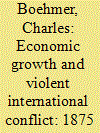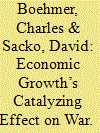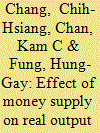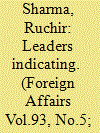|
|
|
Sort Order |
|
|
|
Items / Page
|
|
|
|
|
|
|
| Srl | Item |
| 1 |
ID:
187798


|
|
|
|
|
| Summary/Abstract |
This paper is a preliminary attempt to use both the value added approach with double deflation and the expenditure approach to deflate China's nominal GDP over 15 years (2004–2018). The results show that China's real GDP growth during the period has significantly more fluctuations than the official statistics indicate. Additionally, inflation, as measured by the official implicit GDP deflator, is generally overestimated during boom years but underestimated during downturn years. In particular, it is shown that China's growth slowdown in recent years before the COVID-19 pandemic may have been more severe than official figures suggest.
|
|
|
|
|
|
|
|
|
|
|
|
|
|
|
|
| 2 |
ID:
096268


|
|
|
|
|
| Publication |
2010.
|
| Summary/Abstract |
Are states with growing economies more likely to become involved in violent interstate conflicts? This project examines whether economic growth increases international conflict using a global sample of states from 1875-1999. The theory argues that multi-year economic growth increases the resolve of state leaders to reciprocate and escalate militarized interstate conflicts, thus increasing the occurrence of fatalities or war. The results show that economic growth, but not growth of military expenditures, raises the risk of violent interstate conflicts. The results do not support the proposition that economic slowdowns result in violent interstate conflicts.
|
|
|
|
|
|
|
|
|
|
|
|
|
|
|
|
| 3 |
ID:
192057


|
|
|
|
|
| Summary/Abstract |
This paper explains the circumstances where economic growth increases the likelihood of interstate war. Optimism created by high and sustained economic expansion permeates a state, increasing elite and mass optimism for the use of deadly force. Without relief, such unbridled sanguinity can lead states to war. However, other forces reduce the probability of war. Regional democracy, bilateral trade, and trade openness slow down the process where states go to war. This paper hypothesizes that key factors raise the temperature of disputes, increasing the likelihood of a political dispute combusting to war, while other attributes inhibit the process to war. Economic growth catalyzes such reactions, while regional and joint democracy impede the probability that a war sparks. This paper produces monadic and dyadic results demonstrating that economic growth increases the likelihood of war, while other factors such as interstate trade openness, bilateral trade, dyadic democracy, and regional democracy slow down the process of war, making war less likely.
|
|
|
|
|
|
|
|
|
|
|
|
|
|
|
|
| 4 |
ID:
086606


|
|
|
|
|
| Publication |
2009.
|
| Summary/Abstract |
Over the past 30 years, China has achieved remarkable long-term economic growth. Using quarterly data, we study the effects of money supply on real output and inflation in China between 1993 and 2008. To this end, we use money supply shocks after filtering out the expected component of the money supply. Our findings provide evidence supporting the asymmetric effect of positive and negative money supply shocks on real output and inflation in China. That is, real GDP growth in China responds to negative money supply shocks but not positive money supply shocks. In addition, inflation responds to positive money supply shocks but not negative money supply shocks. We conclude that the People's Bank of China's policy of steady monetary growth appears to be appropriate. Our study offers important policy implications for China.
|
|
|
|
|
|
|
|
|
|
|
|
|
|
|
|
| 5 |
ID:
119811


|
|
|
|
|
| Publication |
2013.
|
| Summary/Abstract |
Based on an econometric analysis of the annual growth data for China's GDP and electricity generation from 1953 to 2010, we find that electricity generation growth Granger causes GDP growth, but not vice versa. We also find that the GDP elasticity of electricity generation is about 0.6, implying that a 1% increase in China's electricity generation growth would increase GDP growth by 0.6%. While Deng's reform raised China's GDP growth rate by about 5% per year, it did not alter the GDP elasticity of electricity generation. Hence, an obvious strategy to promote China's economic growth would be accelerating electricity generation expansion. Rapidly adding thermal generation units, however, could have large-scale, adverse environmental impacts. We therefore support China's 2011 five-year plan, which calls for expanding investments in renewable energy, conservation and energy efficiency as well as improving China's integrated electricity planning and cost-based pricing decisions.
|
|
|
|
|
|
|
|
|
|
|
|
|
|
|
|
| 6 |
ID:
133669


|
|
|
|
|
| Publication |
2014.
|
| Summary/Abstract |
Global investors usually focus on economic data such as GDP growth, employment, and trade. But in today's trying economic climate, they have started to train their gaze elsewhere: on national political leadership and the prospects for reform.
|
|
|
|
|
|
|
|
|
|
|
|
|
|
|
|
| 7 |
ID:
126265


|
|
|
|
|
| Publication |
2014.
|
| Summary/Abstract |
Just over a year ago, as President Enrique Peña Nieto started his administration, the domestic and international press were touting "Mexico's moment" and the rise of "the Aztec tiger." Now, the naysayers have returned. Their pessimism stems in part from disappointing economic results: Mexico's GDP growth has fallen, from nearly four percent in 2012 to around an estimated one percent in 2013. The negativity also reflects the impatience of pundits and markets, as the economic dividends from Peña Nieto's ambitious economic reform agenda have yet to appear.
|
|
|
|
|
|
|
|
|
|
|
|
|
|
|
|
| 8 |
ID:
112393


|
|
|
|
|
| Publication |
2012.
|
| Summary/Abstract |
This study uses the Feder-Ram model in conjunction with the military Keynesian model to examine the nexus between defence spending and economic growth in Sri Lanka. We find that the Keynesian aggregate demand model is better suited to analyse the link than the Feder-Ram model for the case of Sri Lanka. Based upon our results we expect a higher economic growth rate in Sri Lanka if more public resources are diverted from the defence to civilian sectors of the economy, now that the war between the government and separatist guerrillas has come to an end. However, recent post war events cast doubt upon whether a diversion of sources from military to non-military spending will actually occur. We conclude that the sanguine predictions of our economic analysis are entirely dependent upon the political decisions of the Sri Lankan government for their realization.
|
|
|
|
|
|
|
|
|
|
|
|
|
|
|
|
|
|
|
|
|